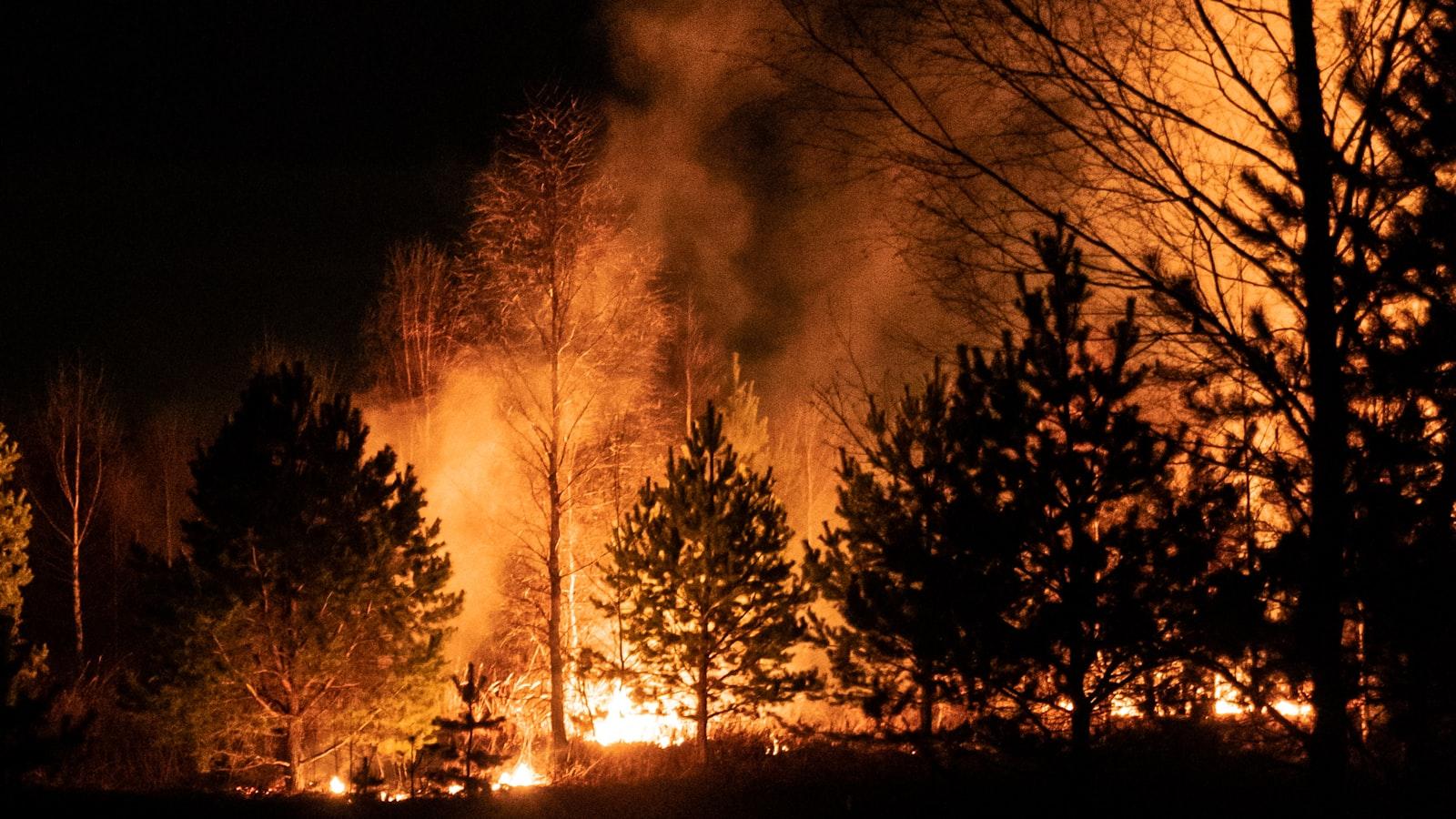The dance of destruction engulfs the untamed wilderness, swirling in hues of fiery red, as bewildered flames consume the vibrant tapestry of nature. Wildfires, both mesmerizing and monstrous, have long been a part of the Earth’s eternal cycle. Yet, beyond the spectacle, a hidden menace lurks, emerging from the grasp of this inferno – smoke. Cast upon the winds, it travels with sinister grace, weaving its way into the very air we breathe. In this article, we delve into the intricate connections between wildfires, smoke, and their profound impact on air quality and public health. Join us as we embark on a journey that unravels the enigma of this fiery dance, exploring the consequences it presents to our delicate ecosystems and our very own well-being. Welcome to the realms of wildfires and smoke: where the air weighs heavy with truths yet untold.
Understanding the Link between Wildfires, Smoke, and Air Quality
Wildfires are a natural occurrence, often started by lightning strikes or human activities, such as campfires or discarded cigarettes. When these wildfires ignite, they release large amounts of smoke and pollutants into the air. The smoke contains particles, gases, and chemicals that can travel for miles, impacting the air quality in surrounding areas.
One of the main concerns associated with wildfires and smoke is the effect they have on air quality and public health. The fine particles in smoke, known as particulate matter, can be extremely harmful when inhaled. These particles are so small that they can penetrate deep into the lungs and even enter the bloodstream, causing respiratory problems, eye irritation, and cardiovascular issues. People with pre-existing respiratory conditions, such as asthma or chronic obstructive pulmonary disease (COPD), are particularly susceptible to these health effects. Children, older adults, and individuals with compromised immune systems are also at higher risk.
When it comes to air quality, wildfires can significantly deteriorate the condition of the air we breathe. The smoke from wildfires contains pollutants such as carbon monoxide, nitrogen oxides, and volatile organic compounds, which can contribute to the formation of ground-level ozone. This can have far-reaching consequences, as high levels of ozone can exacerbate respiratory problems, trigger asthma attacks, and cause other respiratory symptoms. Additionally, certain compounds in the smoke, such as polycyclic aromatic hydrocarbons (PAHs), can have long-term effects on air quality and even contribute to climate change.

Impacts of Wildfires on Public Health and the Environment
Wildfires and smoke have a significant impact on air quality and public health. The release of pollutants and toxins during wildfires can result in poor air quality, leading to various health issues for both humans and the environment.
1. Health Impacts:
- Respiratory Problems: The smoke from wildfires contains harmful particles and gases, which can irritate the respiratory system and exacerbate existing respiratory conditions such as asthma, bronchitis, and chronic obstructive pulmonary disease (COPD).
- Cardiovascular Effects: The fine particles in the smoke can enter the bloodstream and increase the risk of cardiovascular problems, including heart attacks and strokes. This is particularly concerning for individuals with pre-existing heart or vascular conditions.
- Eye and Skin Irritation: Exposure to smoke can cause eye irritation, redness, itching, and even temporary vision changes. It may also lead to skin reactions such as rashes and itching.
- Mental Health Impact: Wildfires can have a psychological impact on individuals, causing increased stress, anxiety, and feelings of loss or grief, especially for those directly affected by the destruction of their homes or communities.
2. Environmental Consequences:
- Loss of Biodiversity: The destruction caused by wildfires can lead to the loss of plant and animal species and disrupt delicate ecosystems, making it difficult for them to recover.
- Water Contamination: The ash and debris from wildfires can contaminate nearby water sources, posing a risk to aquatic life and potentially affecting drinking water quality.
| Health Impact | Environmental Consequence |
|---|---|
| Respiratory problems | Loss of biodiversity |
| Cardiovascular effects | Water contamination |
| Eye and skin irritation | |
| Mental health impact |
It is crucial to prioritize efforts in preventing and managing wildfires to protect both public health and the environment. Adequate measures such as early detection, prompt fire suppression, and effective communication with the public can help mitigate the impacts of wildfires on air quality and overall well-being.
Mitigating the Health Effects of Wildfire Smoke Exposure
Wildfires and Smoke: How They Affect Air Quality and Public Health
Wildfires not only pose a threat to forests and wildlife but also to human health due to the smoke they generate. The exposure to wildfire smoke can have severe implications on air quality, resulting in a range of health issues for individuals, especially those with pre-existing conditions. Understanding the impacts and taking necessary measures to mitigate the health effects of wildfire smoke exposure is paramount to ensuring the well-being of communities living in affected areas.
Smoke emitted from wildfires contains a mixture of harmful pollutants such as particulate matter, toxic gases, and volatile organic compounds. These pollutants can infiltrate deep into the respiratory system, causing respiratory distress, exacerbating lung conditions, and increasing the risk of heart attacks and strokes. The health effects are not limited to the respiratory system; prolonged exposure to smoke can also lead to eye and throat irritation, headaches, and exacerbation of asthma symptoms.
- How to protect yourself from wildfire smoke:
- Stay indoors and keep windows and doors closed to minimize smoke intrusion.
- Use air purifiers with HEPA filters to maintain indoor air quality.
- Avoid strenuous outdoor activities in smoky areas, especially for vulnerable individuals like children and the elderly.
- Follow local air quality advisories and evacuation orders if necessary.
- What can communities do to reduce the health effects:
- Implement measures to prevent wildfires or reduce their severity, such as controlled burns and forest management practices.
- Invest in advanced air monitoring systems to provide accurate, real-time data on air quality during wildfire events.
- Establish community centers as safe zones or temporary shelters during wildfires.
- Ensure access to healthcare services and resources for affected communities, including masks and medical assistance.
While the immediate focus during wildfires is often on containment and extinguishing efforts, addressing the health effects of smoke exposure is equally vital. By understanding the risks posed by wildfire smoke and taking proactive measures, communities can protect their residents and ensure public health remains a top priority even in the face of these destructive events.

Responding to Wildfires: Recommendations for Effective Air Quality Management
Wildfires and Smoke: How They Affect Air Quality and Public Health
Wildfires pose a significant threat not only to the natural environment but also to public health and air quality. The smoke emitted during these fires contains a dangerous mix of particles and pollutants that can have severe consequences on the well-being of individuals living in affected areas. The impact of wildfires on air quality goes beyond the immediate vicinity of the blaze, as the smoke can travel for miles, affecting a larger population. It’s crucial for communities to understand the detrimental effects of wildfires on air quality and take proactive steps to mitigate the risks.
The Effects of Smoke on Air Quality
The smoke released by wildfires contains fine particles, gases, and chemical compounds that can have both short-term and long-term effects on air quality. These particles, known as particulate matter (PM), can penetrate deep into the lungs, causing respiratory issues and exacerbating existing conditions such as asthma and allergies. In addition to PM, wildfires also release pollutants like carbon monoxide, nitrogen oxides, and volatile organic compounds (VOCs), which can contribute to the formation of ground-level ozone and smog. Moreover, these pollutants can have cardiovascular effects, leading to heart problems and other health complications.
To effectively manage air quality during wildfires and protect public health, it is essential to follow recommendations provided by experts. Some key measures include:
- Stay informed: Regularly check air quality updates from local air monitoring agencies to stay updated on the current conditions and take necessary precautions.
- Avoid exposure: Minimize time spent outdoors, especially during peak smoke hours when air quality is at its worst.
- Use air filtration devices: Consider using high-efficiency particulate air (HEPA) filters or portable air cleaners to remove smoke particles from indoor air.
- Closed-door policy: Keep doors and windows closed to prevent smoke from entering your home, and use weather stripping to seal any gaps.
In addition to these recommendations, it is important for individuals with pre-existing respiratory conditions to consult with their healthcare providers for tailored advice on managing their health during wildfire events. By implementing these measures and prioritizing air quality management, we can collectively work towards minimizing the impact of wildfires on our communities and safeguard public health.
Future Outlook
As the embers fade and the smoke dissipates, it is crucial to understand the formidable impact of wildfires on air quality and public health. Through the haze, we have explored the intricate dance between flames and the atmosphere, uncovering the untold consequences of their passionate tango.
In our journey through burnt landscapes and choking smoke, we have witnessed the invisible bond that links these destructive wildfires to the air we breathe. The billowing plumes, pregnant with harmful substances, not only paint the sky with an ashen hue but also cloak our lungs in a silent threat. It is a captivating, yet dangerous symphony that demands our unwavering attention.
The intricacy lies in the smoke’s deceptive allure, veiling the true magnitude of its impact. It does not discriminate, sweeping across hills and valleys, reaching even the farthest corners of civilization. It wraps its suffocating tendrils around homes, schools, and communities, leaving no soul untouched. From the elderly and children to the robust and young, it takes no prisoners in its relentless pursuit of dominance.
Beyond the immediate threat of smoke inhalation, wildfires, like mythical creatures, unleash a legion of secondary consequences upon our delicate ecosystems. The once thriving flora and fauna, reduced to a barren wasteland, set ablaze a chain reaction of disruption. The cascading effects reverberate through the very fabric of life, altering the delicate balance that nurtures our existence.
Despite the devastated landscapes and tainted air, the hope flickers like a resilient flame. Our collective efforts to monitor, mitigate, and adapt to this peril are paramount. With the flames of knowledge and perseverance, we ignite a beacon of awareness to guide us out of the smoke-filled abyss.
So as we bid farewell to the pages that unravel the reality of wildfires and their solemn dance with air quality, let us remember the solemn responsibility that lies in our hands. For it is only through our unity, resolve, and unwavering dedication that we can rise above the ashes, shielding the sanctity of the air we breathe and preserving the public health of generations yet to come.



